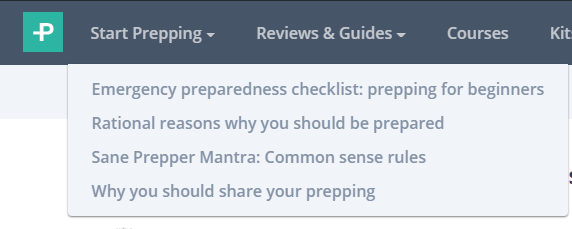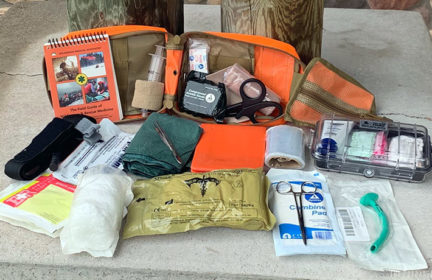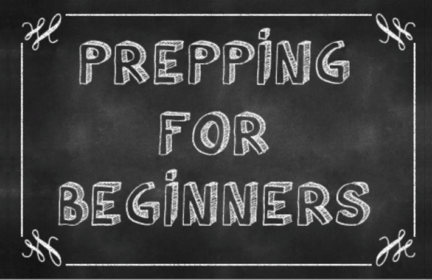Prepping organization (diary / journals / to-do / lists / etc)
I’m fairly new to prepping though I’ve been looking at The Prepared for a while now. There’s a lot going on and a lot of data to take in, and I’m feeling a little bit overwhelmed about how to organize all of it; how to prioritize all of it.
What are your ways to organize all your preps? So far I have some food and water, half constructed bug out bags, some car safety stuff. Not much for winter yet. Different things are stored in different parts of the house. My skills are also a little bit over the place.
Last night I thought about some sort of Prepping Journal, something similar to Gardening Journals, but specifically for prepping. I found a website which recommended making a bullet journal, but otherwise there really isn’t much out there.
I do feel like getting a hold of the organization will help me know where to focus and how to prioritize. I’m happy to hear how everyone organizes all of it.
-
Comments (10)
-
Bob - December 31, 2020
Jason, you’re on the right path. Joining an organization will save you time and money.
There are prepper pubs but usually too broad of scope for those beyond the Boy Scout / Girl Scout first aid kit. For example, Sarah is in earthquake-rain country. Seasons 4 is in cold weather territory. I’m in Hurricane Alley.
My prepping uses basic industrial inventory processing and controls. For example, my acquisition of dry cell batteries gets each blister pack / plastic tub labeled with a long axis yellow stick-on with btry expiration date. Medical, dental, hygiene stuff gets priority and not packed into kits (although kits/pouches below these supplies) until ready to “roll” (usually “walk”). Food already packed in bags like American Tourister flight bag. Rotation method used to max. Document pouch checked frequently. Just had 2nd singles shot of a 2 shot series so CDC 731 pamphlet displays this (by both entry and visible invoice from provider).
Water and DEET spray already in jungle type 4 pocket shirt and field jacket. Rotation method used as if shirt and jacket were shelving.
The more involvement with area’s community, both public sector and private sector, will allow for the needed focus to all this.
Will close with 1 obscure point. The current Boy Scout merit badge pamphlet for their Emergency Preparedness badge, mentions something usually not showing up in the FEMA, CDC, HHS pubs. Have a supply of rags.
-
Gideon ParkerStaff - December 31, 2020
I too was overwhelmed at the beginning of my prepping journey. So much to learn, and all these people were showing off their multi-thousand dollar bug out bags, pantries stocked with years of food, living totally off grid and self reliant, and driving bug out vehicles that could withstand tank fire. haha. How would I ever get to that level of preparedness!?
I think one of the first steps to not be overwhelmed is to do a threat model, as described so well in this forum post. You need to think about what you are most likely to have to survive and deal with, and tackle those first in a sane, rational way. For example, the likelihood of having to survive a nuclear war and live in an underground bunker is a lot lower than losing your job and having to live off of food storage and an emergency fund until you can find a new one. Once I did some threat modeling, I realized that I need to start at the basics of storing up 3 months of food and water. This bit of preparedness is something I can do a little bit each week and eventually achieve. And having the foundation of food and water storage is key to pretty much all other disasters and scenarios that you can encounter.
The Prepared has some great articles that I HIGHLY encourage everyone getting into the world of prepping start out with. Click on the “Start Prepping” button at the top of your screen.
That is the great thing about The Prepared. We are trying to prep sanely and rationally for the disasters most likely to affect us first. And everyone here on the forum is helpful, kind, and knowledgeable. We love to give advice to others, so feel free to jump in, ask anything, and get some of the best help out there on the internet.
-
10 Canadian Winters - December 31, 2020
Thank you for the reply, Gideon. (and Bob too).
I have read the start prepping section of the prepared multiple times :P, and I will for sure refer to it again :). This site is full of great resources and is my go to for anything prepping. I will make sure to read that forum post, thank you for the share.
I think maybe I didn’t explain myself properly (I’m a trilingual French Canadian, so I’m unable to properly express myself in any language :P). Bob explains very pragmatic processes of putting expiry dates on buckets, and that’s great, but how do you know how many buckets you have? how much food you have, of what (protein, veg, etc)? what you need to get next? If your preps are all over the house do you keep an inventory somewhere, like in a binder or something. Or do you have to go through all your preps all the time and go… I feel like I had stashed this thing over in that closet, and won’t you forget?
I guess I’m looking for a way to itemize/inventory my preps and knowledge in a way which allows me to expand on it. I have looked at the Kit builders for that, and I think at the micro level they work great (this is everything in my Bug out Bag), but less so at a “this is all my prepping” level. I think everyone has a different way to work at that level, but I’m quite curious how people organize it not to get lost in all the preps they accumulated for all the various emergency situations. Especially since some preps are good for many emergencies, but at same time you shouldn’t double dip. And like for the threat modelling, I should record that somewhere, I think, so it goes back to my “How to organize your prepping” idea.
Hopefully I’m making sense.
-
Gideon ParkerStaff - December 31, 2020
Yes, that totally makes sense. I’m sorry I didn’t address the main portion of your question. Guess I was focused on helping you not feel so overwhelmed.
I’ve tried multiple things from excel spreadsheets to apps and personally haven’t found a good solution for me. I’ve been wanting to get serious about having a well stocked and organized food storage, but that would involve some way to track what I have and what I need. Like you were saying.
The closest I think I could get to the perfect inventory system would be an excel spreadsheet. Have a new tab for each room of the house, and on that tab list things such as item, location in room, quantity, expiration date, any monthly or yearly maintenance (such as rotating batteries), any warranty with the item, etc…
Setting calendar reminders on my phone is helpful for those larger purchases. I have a reminder 25 years from now that my freeze dried food bucket is going to expire, and another reminder 5 years from now to get a new pepper spray.
Once I move to a larger house and have a dedicated food storage and prepping closet, then i’ll be able to organize much better! I’m really looking forward to that.
-
Alicia - January 3, 2021
In Jan 2020, I planned to get more serious and better organized in my ‘partial and then neglected for a few years’ preparedness. What fortuitous timing given the Pandemic that was coming. I have found my solution in a large excel workbook of spreadsheets. I have them by category instead of by location (thanks Marie Kondo). Some categories aren’t lists but record of threat evaluations like mentioned earlier which I added Pandemic to recently. First Aid is one sheet and I then treat it much like a data base with each item on a line that I can search, filter and add columns for attributes – like source of the recommendation for this item to be included in a first aid kit, level of first aid kit as described in the Kits area on this site, expiration dates. So on that page I have first aid kit lists from about a dozen sources until I settled on what I wanted in mine – an in/out column – and it also has columns for the various first aid kits and their locations: car get home bag, work FAK, bug out bags (mine and my husband’s which are slightly different due to medications). Then on the BOB/GHB page I just list FAK and know that the details are on the other sheet. This single location has been helpful as I learned what worked better for my way of thinking. So it has evolved over time as it started by kit instead of category. I also need to review this at least yearly as I review/inspect/exercise my preps
-
Gideon ParkerStaff - January 3, 2021
That sounds like a really great organization method! I might have to steal the idea for my preps. 🙂
-
Alicia - January 4, 2021
🙂
-
-
Dog lover - January 3, 2021
I don’t believe there is any one master list to go by. I think you first need to decide what you are prepping for primarily. Let’s say it’s for a thirty day amount of supplies in case you’re isolated and unemployed. Kind of like what a lot are going through during this pandemic. With that in mind make a personalized list of every food, supply, and expense that you would need for that amount of time. You can check off the items on the list as you collect them. Once you complete your first list then make additional more specialized lists. Like a first aid bin. I use large plastic totes to organize different items in. I don’t keep lists in any of the totes but it’s a really good idea. That way as you pull items out you can have a record of what needs replacement. This would also be good to keep up with expiration dates.
One thing I do that really helps me is an app on my phone for things I need to do or buy. Since I suffer from CRS now, (can’t remember something), whenever I think of an item I want it goes on the list for when I’m out at the store. I use google keep but am sure there are loads of free apps out there to choose from. -
Seasons4 - January 4, 2021
Good question — How to organize and prioritize preps? I keep one overall “to do” list for my life, and I add things to buy or sort or think about to that list. I come up with prepping ideas from reading this site primarily. Rather than keeping additional lists, I like to use visual cues. For example, I moved a bookcase into the dining area and use it as an open-air pantry. I can see at a glance what needs replenishing. I make it a point to look into closets and cupboards and notice what’s there and what needs replacing, then write it on the to-do list.
Rather than one large BOB, I have maybe half a dozen small BOB’s near the front door. (Easier on my back and joints and easier to balance going down stairs.) I’ve labeled each bag with the general contents so I don’t have to look inside to remind myself what’s there. One bag contains only paper records, including passwords. I don’t rely on my memory to recall what’s in each bag, especially in an emergency when I would probably be distracted. I keep my vehicle stocked with tools, winter gear, sleeping bags, tarps, things that might come in handy and which would take too much time to load in an emergency evacuation scenario.
I live in a small space, so it’s necessary for me to give up an interior design aesthetic where there are only beautiful things to look at in every direction, with other things hidden behind closet doors or in other rooms. For example, I’m an amateur radio operator. I have a small beam antenna in the dining area, with coax cable on the floor attached to the radio on the other side of the area. To keep the antenna mast upright, I placed it in a 5-gallon pail filled with water-softening salt as an anchor. Between the open-air bookcase pantry and the antenna in a plastic pail, my dining area won’t win any interior design awards, but that’s ok. In this pandemic, I can’t entertain people anyway. 🙂
I agree with what’s been said. Plan for what’s most likely. Figure out how to sustain yourself and your loved ones for a week at a time, then two weeks, then three weeks, etc. Sheltering in place is generally safer and more sustainable. In case you have to leave, I believe it’s important to have destinations in mind — friends, relatives, acquaintances who would help you in a pinch. Best regards to you.
-
pnwsarahContributor - January 5, 2021
Hi Jason!
Like others on this thread, I’ve found that an Excel workbook with multiple “sheets” is what works for me, but I also use the Kit Builder feature in conjunction with that.
My sheets are:
- Bug out bag – inventory of the BOB by category (e.g., food, water, shelter, clothing). Each item has a short name, a product name (hyperlinked to where I bought or plan to buy it from), weight, price, disaster scenario I need it for, and comments.
- Get home bag – What I keep at the office to help me get home. Same info for each item as on the BOB list.
- Car supplies – Same idea as GHB and BOB list.
- Home – Inventory of everything I keep at home for prepping purposes, including BOB contents. I have a column here for “location” to indicate whether it’s in the BOB, in an Action Packer that we keep full of prepping stuff, or in another location in the house. This doesn’t include food or first aid supplies, since that would make the list maddeningly long. Those get their own sheets…
- Food Supplement – Detailed list of all the food in the BOBs, in the pantry, and in the ActionPacker, for the humans and the dog, with total calories per person and per dog.
- Medical Supplement – Detailed list of all the medical supplies we keep in the house.
- Power – list of devices I would want to be able to charge in a power outage and power sources and what kind of cables they require (e.g., micro-USB), and what they plug into, so I can make sure that everything matches up.
Again, these are all in one “workbook” (i.e., one document) so I can click among them easily. Some of the sheets are really a mess/incomplete/unfinished (e.g., the medical one) while some of them (e.g., the BOB, GHB, and food supplement, and power sheets) are in great shape, and the remainder are somewhere in between; I’m just sort of getting them up and running one by one as I have time/am craving a rainy weekend afternoon of spreadsheet nerdery.
I use the Kit Builder mainly to budget and prioritize my remaining prepping purchases. So, I have a kit called “Remaining Preps Prioritization” which is not actually a kit, but rather a list of equipment/gear I still need to buy sorted by month in which I intend to purchase it, which helps me easily reprioritize my to-be-acquired preps while staying under a monthly budget. For example, we had a lot of civil unrest and a lot of teargas flying around my city this summer and then really bad air quality from fire, and with the election and potentially more fire on the horizon, gas masks got bumped up, while some other items got demoted to post-election rainy-season months. (This strategy comes from a blog post by Jon Stokes that is really worth a read.)
-
- Neutrality for the sake of survival and how to manage the full spectrum of ideologies - 14 hours ago
- Essential medical reference books for the prepper library - 18 hours ago
- News for the week of 2024-07-22 - 18 hours ago
- AR15 stock weight - 4 days ago
- Burning Candles - 5 days ago
This forum is heavily moderated to keep things valuable to as many people as possible. Full community policies are here. The basics:
- 1. Be nice to each other.
- 2. Stay focused on prepping.
- 3. Avoid politics, religion, and other arguments.
- 4. No unfounded conspiracies, fake news, etc.
- 5. Debate ideas, not people.



